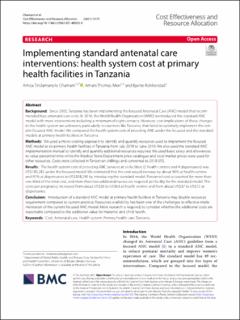| dc.contributor.author | Chamani, Amisa Tindamanyile | |
| dc.contributor.author | Mori, Amani Thomas | |
| dc.contributor.author | Robberstad, Bjarne | |
| dc.date.accessioned | 2022-01-28T13:10:07Z | |
| dc.date.available | 2022-01-28T13:10:07Z | |
| dc.date.created | 2022-01-01T14:17:40Z | |
| dc.date.issued | 2021 | |
| dc.identifier.issn | 1478-7547 | |
| dc.identifier.uri | https://hdl.handle.net/11250/2940283 | |
| dc.description.abstract | Background
Since 2002, Tanzania has been implementing the focused Antenatal Care (ANC) model that recommended four antenatal care visits. In 2016, the World Health Organization (WHO) reintroduced the standard ANC model with more interventions including a minimum of eight contacts. However, cost-implications of these changes to the health system are unknown, particularly in countries like Tanzania, that failed to optimally implement the simpler focused ANC model. We compared the health system cost of providing ANC under the focused and the standard models at primary health facilities in Tanzania.
Methods
We used a micro-costing approach to identify and quantify resources used to implement the focused ANC model at six primary health facilities in Tanzania from July 2018 to June 2019. We also used the standard ANC implementation manual to identify and quantify additional resources required. We used basic salary and allowances to value personnel time while the Medical Store Department price catalogue and local market prices were used for other resources. Costs were collected in Tanzanian shillings and converted to 2018 US$.
Results
The health system cost of providing ANC services at six facilities (2 health centres and 4 dispensaries) was USD185,282 under the focused model. We estimated that the cost would increase by about 90% at health centres and 97% at dispensaries to USD358,290 by introducing the standard model. Personnel cost accounted for more than one third of the total cost, and more than two additional nurses are required per facility for the standard model. The costs per pregnancy increased from about USD33 to USD63 at health centres and from about USD37 to USD72 at dispensaries.
Conclusion
Introduction of a standard ANC model at primary health facilities in Tanzania may double resources requirement compared to current practice. Resources availability has been one of the challenges to effective implementation of the current focused ANC model. More research is required, to consider whether the additional costs are reasonable compared to the additional value for maternal and child health. | en_US |
| dc.language.iso | eng | en_US |
| dc.publisher | BioMed Central | en_US |
| dc.rights | Navngivelse 4.0 Internasjonal | * |
| dc.rights.uri | http://creativecommons.org/licenses/by/4.0/deed.no | * |
| dc.title | Implementing standard antenatal care interventions: health system cost at primary health facilities in Tanzania | en_US |
| dc.type | Journal article | en_US |
| dc.type | Peer reviewed | en_US |
| dc.description.version | publishedVersion | en_US |
| dc.rights.holder | Copyright 2021 The Author(s) | en_US |
| dc.source.articlenumber | 79 | en_US |
| cristin.ispublished | true | |
| cristin.fulltext | original | |
| cristin.qualitycode | 1 | |
| dc.identifier.doi | 10.1186/s12962-021-00325-0 | |
| dc.identifier.cristin | 1973241 | |
| dc.source.journal | Cost Effectiveness and Resource Allocation | en_US |
| dc.identifier.citation | Cost Effectiveness and Resource Allocation. 2021, 19, 79. | en_US |
| dc.source.volume | 19 | en_US |

